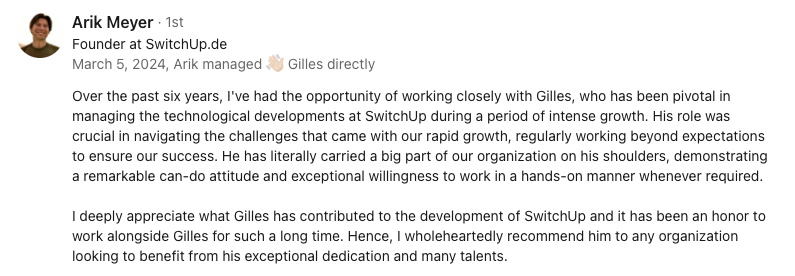Abstract:
The article explores the challenges faced by European startups, emphasizing resource constraints in financial, technical, and human aspects that hinder growth and innovation. It illustrates the common scenario of a startup founder in a Berlin café, driven by ideas but limited by resources. The narrative highlights how startups can navigate these challenges by leveraging new technologies, forming strategic partnerships, and optimizing talent. Utilizing cloud platforms like AWS and open-source frameworks such as TensorFlow helps manage costs and enhance scalability. Engaging with tech communities and forming alliances with research institutions provide access to resources and knowledge, fostering innovation. The article also stresses the importance of attracting and retaining talent through equity, flexible work, and a strong company culture, while advocating for upskilling and remote work to overcome skill shortages. Moreover, it addresses compliance with EU regulations, ethical AI considerations, and the importance of measuring success in deep learning initiatives. Through these strategies, startups can transform constraints into opportunities, driving innovation and ensuring long-term success in the competitive European market.
Navigating the world of European startups can sometimes feel like solving a puzzle with missing pieces. You have the vision and drive, but limited resources can seem like big hurdles. Whether it's finding enough funding, keeping up with technology, or hiring the right people, these challenges can test anyone.
Picture yourself in a busy café in Berlin, laptop open, buzzing with ideas, yet feeling stuck because of resource limits. This is a common situation for many European startups. The path to innovation is full of challenges that require creativity and strategic thinking. I've seen startups in Berlin and Lisbon transform these constraints into opportunities for growth.
Let's explore how startups can tackle these challenges using new technologies, partnerships, and optimizing talent. It's all about thriving despite the constraints and ensuring innovation not only survives but flourishes.
Understanding Resource Constraints in European Startups
Defining Resource Constraints
European startups often face resource constraints, which are a tough reality. These constraints are financial, technical, and human, each affecting a startup's growth and ability to innovate. Limited budgets can make it hard to secure the necessary capital. Technical constraints arise from lacking infrastructure and the high costs of new tech. Additionally, there's a shortage of skilled professionals, especially in AI and deep learning. These aren't just hurdles; they're crucial issues European startups must navigate to succeed.
Having worked in European tech, I've observed how these constraints can hold back progress. It's a tricky balance of managing resources while aiming for innovation and growth.
Financial Challenges and Budgetary Restrictions
European startups often struggle with financial challenges that impact their operations. Access to venture capital is limited, especially compared to places like Silicon Valley. High operational costs can quickly drain resources. Startups also face the expense of acquiring necessary technology. Here's a quick look at some common financial constraints:
- Limited access to venture funding
- High operational costs
- Expensive technology acquisition
These financial limits force startups to make tough decisions about resource allocation. Financial prudence becomes crucial in determining success paths amidst these challenges.
Technical Constraints and Infrastructure Challenges
Technical challenges are significant, especially when scaling deep learning. Limited infrastructure can slow down efforts, making it hard to obtain the needed computational power. Additionally, the quality and availability of data are ongoing issues. Deep learning requires extensive high-quality data, but startups often deal with data scarcity or subpar datasets. In Berlin, I've seen many promising ventures face delays because their technical resources couldn't meet their ambitions.
Human Resource Challenges: Talent Shortages in AI
The scarcity of skilled professionals in AI is particularly pressing. Demand far exceeds supply, making it tough for startups to recruit and retain talent for deep learning projects. This isn't just about numbers; it's about finding the right expertise. Moving from China to Europe, I noticed the talent gap, highlighting the need for strategies to attract and develop skills. Partnerships with universities or offering remote work options can be effective strategies for attracting AI talent.
Understanding these constraints is crucial for evaluating their impact on startups' ability to innovate and scale.
Leveraging Cloud and Open-Source Technologies
Cloud Platforms as a Cost-Effective Solution
Cloud platforms have transformed how startups manage resources by offering scalable, affordable options. AWS, Google Cloud, and Microsoft Azure provide high-performance computing without large upfront investments. This pay-as-you-go model allows startups to scale efficiently while managing costs. A startup in Berlin, for example, relied heavily on cloud resources to manage a tight budget while advancing AI technology.
Benefits of cloud platforms include:
- Integrated machine learning tools
- Cost-saving options like AWS spot instances
- Google Cloud's discount programs
- Seamless integration with business tools on Microsoft Azure
Startups have succeeded using these services. A venture in Lisbon used Google Cloud's TensorFlow to streamline operations, achieving scalability quickly. Transitioning from on-premise to cloud reduced costs and increased adaptability.
Open-Source Frameworks to Reduce Costs
Open-source frameworks like TensorFlow and PyTorch help startups reduce development costs and foster innovation. These tools eliminate licensing fees and offer libraries and pre-trained models to accelerate development. Startups can focus on innovation rather than infrastructure.
The communities around these frameworks are a significant advantage. Developers can access documentation, forums, and collaborative projects, reducing development hurdles. Platforms like GitHub offer resources and insights. A colleague noted how community-driven solutions were crucial in overcoming technical challenges during a project phase.
A startup in Berlin effectively used TensorFlow to scale operations, keeping costs low while accelerating product development. The open-source approach maintained flexibility and drove iteration speed.
These strategies demonstrate how cloud services and open-source tools empower startups. By creatively using these technologies, startups can overcome resource constraints and focus on innovation.
Building Strategic Partnerships and Community Ties
Forming Strategic Partnerships
In Europe, forming strategic partnerships is transformative. Partnering with tech giants opens doors to advanced technologies and infrastructure, easing capital investment burdens. Collaborations allow startups to access resources that would otherwise be unavailable. Alliances with research institutions offer access to specialized equipment and knowledge, crucial for deep learning projects. In Berlin, collaborating with a university significantly enhanced our tech access, pushing innovation without overextending our budget.
Research institutions provide expertise and innovation opportunities. Collaborating with academic researchers enables startups to engage in projects that might not be possible alone. Such partnerships encourage continuous learning and keep startups on the cutting edge of technology. In Lisbon, I've seen startups gain a competitive edge through collaborations with educational institutions, sharing successes and learning from failures.
A Berlin startup partnered with a local tech company, accessing vital resources and connections that advanced their deep learning innovations. Shared expertise and resources boosted their projects, demonstrating the power of strategic partnerships in elevating a startup's status.
Engaging with Tech Communities
Engaging with tech communities is a powerful strategy for startups to expand their influence and resources. Involvement provides networking and access to talent. Startups active in tech meetups and forums often lead innovation due to the diverse ideas they encounter. In Berlin, attending local tech gatherings enriched my network, connecting me with like-minded innovators.
Platforms like GitHub and events like TechCrunch Disrupt enhance community engagement, offering stages to showcase innovations and attract interest from investors and partners. GitHub is a hub where developers refine each other's work, creating a dynamic environment that nurtures innovation. Startups also gain exposure and insights at industry events, engaging with trends and gaining inspiration.
An AI startup in Lisbon thrived by engaging with the local tech community, participating in forums and conferences. They attracted talent and gained insights crucial for refining technology. This engagement fostered a support system that was instrumental in overcoming challenges.
Optimizing Talent Utilization and Development
Attracting and Retaining Talent
Startups often struggle to offer competitive salaries due to financial constraints. However, equity and stock options can be enticing alternatives. These incentives offer a stake in future success and foster ownership among employees. In Berlin, offering equity helped build a committed team, as employees felt like partners in the company's journey. Key strategies include:
- Equity and stock options
- Flexible work arrangements
- Strong company culture
While financial incentives are important, flexible work and strong culture are equally vital. A solid company culture, where employees feel valued and part of a vision, attracts talent. In Lisbon, a tech startup offered remote work and impactful projects, making the job more appealing than any paycheck.
Real-world examples show the success of these strategies. A Berlin startup attracted top-tier AI talent and had high retention rates through flexible culture and stock plans, creating an attractive and sustainable workplace.
Upskilling and Leveraging Remote Talent
Upskilling is crucial for boosting a startup's capabilities from within. By investing in training and development, startups create a culture of learning and adaptability. Encouraging employees to learn new skills enhances individual proficiency and the organization’s innovation potential. I've seen training sessions transform team output and morale, reflecting the benefits of a learning environment.
Remote talent pools offer another powerful resource for startups facing skill shortages. The diversity and flexibility of remote teams can invigorate a project. Managing teams across Berlin and Beijing, leveraging remote talent was crucial. It allowed us to integrate diverse perspectives and fill skill gaps. Companies using remote workers increase talent reach, enhancing diversity and inclusion.
Successful startups use remote teams to scale projects efficiently. A Lisbon tech startup tapped into global expertise, rapidly advancing AI development. This strategy brought varied skills and ideas without local hire costs. Remote work's flexibility and diverse talent pool are indispensable, bolstering startups' capabilities.
Navigating Compliance and Ethical Considerations
Navigating EU Regulations
Understanding regulations like the General Data Protection Regulation (GDPR) is crucial for deep learning projects. GDPR focuses on data privacy, impacting project development and deployment. Compliance isn't just checking boxes; it's vital for maintaining trust. Navigating these regulations can seem daunting, but understanding them makes a difference.
Successful navigation of GDPR involves addressing compliance challenges. Startups must ensure data practices align with requirements. Here's a quick checklist:
- Data Minimization: Collect only essential data
- Transparency: Clearly communicate data use
- Consent Acquisition: Obtain explicit consent
- Data Security: Implement robust protection
- Rights Management: Provide rights mechanisms
By addressing these areas, startups can mitigate risks and instill user confidence, crucial for growth.
Startups have skillfully navigated regulatory challenges. A Berlin tech company adapted data methods to comply with GDPR, ensuring compliance and strengthening trust. Their approach to transparency and consent became a model for others.
Ethical Considerations in AI
Ethical AI deployment prioritizes inclusivity, accessibility, and fairness. Projects must embrace these values for broad access. Designing culturally sensitive and inclusive technologies broadens impact. In diverse tech environments, I've seen the value of creating solutions that embrace diversity.
Data privacy and security are crucial for ethical AI. Protecting user data is non-negotiable for trust. In previous roles, stringent data security measures were pivotal in building reliable AI frameworks.
Transparency and explainability enhance trust and accountability. Making AI decisions transparent engages users openly. Reflecting on experiences, transparency in model decisions encouraged user engagement and trust.
Measuring Success and ROI in Deep Learning Initiatives
Key Metrics for Measuring Success
Measuring success is essential for guiding projects. Technical metrics like accuracy and performance assess model effectiveness. Metrics like precision and recall provide insights for improvement.
Success extends beyond technical metrics to financial assessment. Financial metrics like ROI evaluate projects' economic impact, showing how investments translate into benefits. In startups, investing in deep learning is like skipping calorie-heavy cakes for long-term gains.
Operational metrics track efficiency and scalability. These metrics help understand how fast a project can be launched and how well it scales. Consider:
- Time to deployment: How quickly can the model roll out?
- Scalability: Can it handle growing datasets?
- Flexibility: Is the system adaptable?
These metrics enable startups to identify areas needing improvement.
Setting Realistic Goals and Expectations
Aligning deep learning projects with business objectives ensures relevance and focus. Clearly defining how a project meets objectives directs resources wisely. Setting goals is like aligning fitness goals with a health picture, keeping focus even when tough.
Conducting feasibility studies is crucial for success. These studies evaluate project viability, much like assessing terrain before a hike. Evaluating technical needs, data quality, and economic viability helps anticipate obstacles and adjust.
Real-world examples illustrate strategic goal-setting power. A Berlin startup transformed by setting clear, incremental goals led to breakthroughs. Their success echoes fitness journeys where small efforts yield results. Strategic approaches drive innovation and achievement in deep learning.
As you navigate the world of European startups, remember that every challenge can be an opportunity. From financial constraints to talent shortages, today's hurdles can be tomorrow's stepping stones. By embracing cloud technologies and open-source tools, you can turn limits into innovations. Building strategic partnerships and engaging with tech communities bring fresh ideas and resources.
Consider how you can use these insights to not only overcome obstacles but thrive in the competitive market. Your drive and vision fuel your innovation path. How will you apply these strategies to propel your startup forward? Share your experiences and inspire the next big idea, helping others in the community on their startup journeys.
You might be interested by these articles:
- CTOs vs. AI Threats: Securing the Future
- Navigating Deep Learning Innovations
- Maximizing Deep Learning Success Through Teamwork and Innovation





